
Massive Research Initiative Reveals Truth about Ancient Coastal Maya
An international team of archaeologists, anthropologists, and marine scientists has just published a landmark article in the Journal of Island and Coastal Archaeology that details their research into the social and natural processes that shaped the development of the coastal Maya of the legendary Maya culture.
The Proyecto Costa Escondida (Hidden Coast Project) focuses exclusively on the culture of the Maya people who lived (and to some extent still live) along the Caribbean Sea coast on the northern Yucatan Peninsula. It covers a time frame that begins around 800 BC and extends up to the present day.
For the most part, the scientists involved in this comprehensive historical and archaeological study have concentrated their research on the adjacent sites of the ancient Maya port cities of Vista Alegre and Conil. Proyecto Costa Escondida surveys of the coastal region in this area have combined traditional archaeological methods with innovative new techniques for learning about past climate and environmental conditions.
- Uncertain Origins of Ancient Cave Paintings Found in the Yucatan Peninsula
- Chocolate Trail: Sacred Maya Cacao Groves Found In Mexico’s Yucatan
“We chose the project name because the coast is literally hidden behind mangroves,” Georgia State University anthropologist Jeffrey Glover explained to an interview from the GSU Research Magazine. “But at the same time, and more importantly, this region has been hidden from scholarship—there just hadn’t been a lot of work done there until we arrived.”
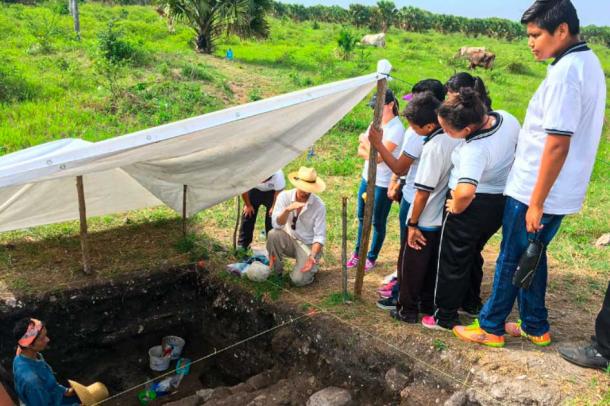
Jeffrey Glover discusses archaeology with local students from Chiquila. (Proyecto Costa Escondida)
What Proyecto Costa Escondida Has Uncovered About Coastal Maya
Vista Alegre is a small island located on the Caribbean side of the Holbox Lagoon, offshore from the city of Chiquila. It would have been a busy port in ancient times, Proyecto Costa Escondida researchers believe, based on the signs of occupation that have been found there. The scientists discovered approximately 40 rock platforms that would have been the foundations of pole and thatch buildings. The largest of these platforms is more than 40 feet (13 meters) tall and would likely have been the site of a temple.
The site at Conil is much larger than the one found at Vista Alegre. It is located just across the Holbox Lagoon from Vista Alegre, on the actual Yucatan coastline. It was visited by Spanish conquistadores in the 16th century, and they identified at that time as a settlement with over 5,000 houses.
During their study of these two sites, the researchers have uncovered or identified tens of thousands of artifacts, ruins, and animal and plant remains, which have revealed valuable information about the ancient coastal Maya culture. Proyecto scientists have also learned a lot about how the landscape and coastal ecology changed over time, through the application of techniques and technologies that can accurately identify environmental conditions in the distant past.
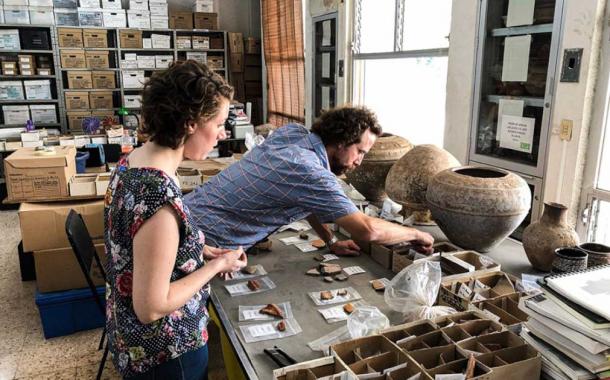
Jeffrey Glover and Carrie Tucker analyze pottery sherds unearthed at Vista Alegre. (Proyecto Costa Escondida)
One fascinating line of research has looked into how sea levels might have changed in the past and how this would have impacted ancient Maya society. Dr. Patricia Beddows from Northwestern University in Illinois checked core sediment samples for their oxygen isotope values, as a way to track changes in sea level and also the likely availability of fresh water. It is thought that rising sea levels in ancient times would have flooded freshwater springs, and therefore limited the availability of drinking water.
To confirm this theory, the team deployed a drone equipped with a thermal camera to fly over coastal areas and search for locations that might have acted as fresh water sources in the past (ground water seeping up from now submerged springs would be colder than the surrounding sea water). The data obtained still has to be studied further, but there is no question that the coastal Maya did experience some notable changes in sea level over the course of centuries.
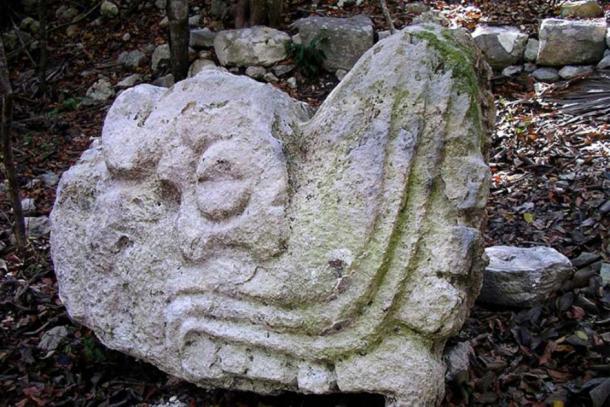
This carved serpent head is what first attracted the team to Vista Alegre. It would have been one of a pair that market each side of stairs leading up to a main pyramidal structure at the site. (Proyecto Costa Escondida)
What Analysis of Marine Life Can Tell Us About the Coastal Maya
Another interesting line of research looked at the remains of marine life found in core sediment samples. Drs. Beverly Goodman-Tchernov and Roy Jaijel from the University of Haifa in Israel found that core samples linked to ancient times contained the remains of tiny sea creatures known as foraminifera which, depending on their type, can survive only in specific environments.
The types of foraminifera found near Vista Alegre were especially interesting, because those creatures would not have been able to survive in the area if the coastal waters were the same as they are today. It would seem that instead of being hidden in the mangroves as it is now, 2,500 years ago Vista Alegre would have been unsheltered and easier for seafarers to spot. It would have attracted traders in their canoes, who would be able to see that it was a bustling port.
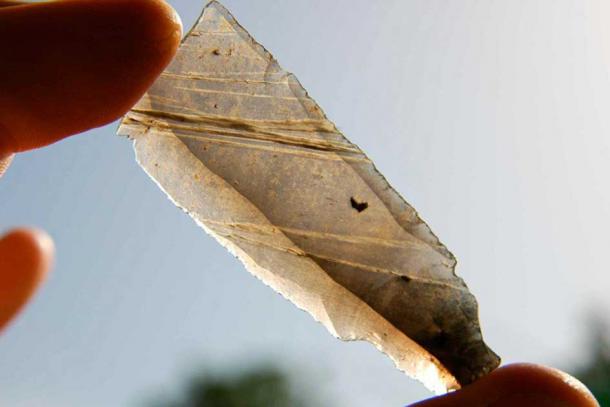
This obsidian volcanic glass blade found at Vista Alegre has provided researchers with valuable clues to the trade networks of the coastal Maya. This obsidian was originally sourced from the highlands of Guatemala, while other came from as far as central Mexico. (Proyecto Costa Escondida)
Bustling Trading Hubs of the Coastal Maya
While the researchers have focused a lot on learning about the ancient coastal environment, they’ve also relied on conventional archaeological approaches to uncover an impressive cache of Maya artifacts. Up to this point they’ve unearthed thousands of pieces of pottery and hundreds of pieces of obsidian, a volcanic glass used to make tools. They’ve also found many spindle whorls, which were used to create cotton thread that could be used to make clothing or fishing nets.
What has been notable is that this collection of artifacts is more diverse than what has been discovered at inland archaeological sites. This shows that the settlements are Vista Alegre and Conil were in fact trading hubs, where it was possible to obtain a broad range of goods brought in by sea. Trading networks linked by canoe and land travel would have helped integrate the Maya Empire more fully, bringing a diverse array of items to active ports wherever they might be found.
These trading networks appear to have reached their most extensive and complex stage about 1,000 years ago. At this time Chichen Itza, a Maya city located on the Yucatan Peninsula approximately 100 miles (160 kilometers) inland from Vista Alegra and Conil, emerged as a major religious, political, and economic center.
Its rise to prominence meant a greater volume of goods would arrive in the Yucatan, impacting locations both inland and on the coast. “Strong evidence of this realignment comes from the obsidian data, which reveals greater connections to parts of central Mexico, near modern day Mexico City,” Dr. Glover said.
The archaeologists have unearthed a treasure trove of items so far. But there’s one thing they’ve been looking for that has proven elusive. “We would love to find an intact ancient Maya trading canoe!” exclaimed Dr. Dominique Rissolo, an archaeologist from the University of California-San Diego who has worked closely with Dr. Glover. “It’s possible that such a vessel may be preserved beneath the muddy bottom of the bays surrounding Vista Alegre. We would learn so much about these legendary watercraft.”
In addition to the artifacts, the researchers also unearthed an impressive number of animal bones, perhaps more than 20,000 in all. This included the bones of sea creatures like rays, sharks, turtles, and marine gastropods, which presumably would have been relied on as food sources.
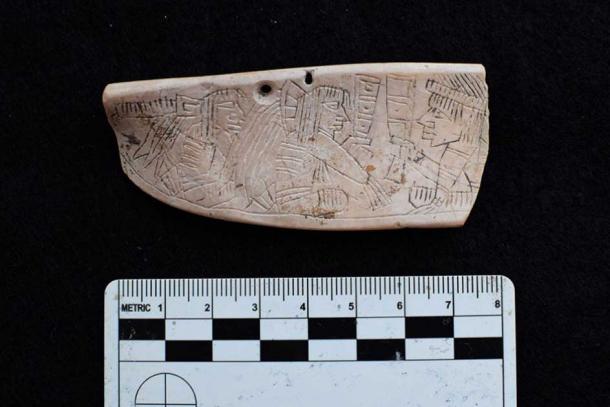
This engraved shell plaque depicts two central seated figures and exemplifies the interpersonal interactions behind long-distance coastal Maya exchange networks. (Proyecto Costa Escondida)
How the Maya Survived
There is a common conception that the ancient Maya society disappeared overnight, as a result of some type of catastrophic event or circumstance that forced survivors into exile. But the best evidence now suggests that no such catastrophe was ever experienced. Maya kingdoms didn’t so much collapse between 800 and 900 AD, but they slowly broke up, resulting in population movements that were not as sudden and dramatic as is often believed.
The descendants of the ancient Maya are still alive today, living in the Yucatan, Guatemala, and Belize. “I think it’s a story, not of a sudden or mass exodus, but a shift over time,” Dr. Glover said. “To understand these shifts we must understand the complex interplay of environmental and cultural factors, which is what our research is revealing.”
Proyecto Costa Escondida scientists have been looking deeper into how the coastal Maya adapted to environmental change. It is believed they did so cooperatively and with an eye on finding collective solutions.
“Our research gives us some idea of the shared challenges that coastal peoples faced – rising sea-levels, diminished freshwater, changing economic and political systems – and they probably leaned on one another,” Glover explained. “In some ways, I think it might have been easier to hop in your canoe and paddle down the coast to seek help than it was to walk over land.”
The Proyecto Costa Escondida was interrupted by the global pandemic, but is now up and running again at full strength. The end for this ambitious project is nowhere in sight, as the researchers who are studying ancient coastal Maya society still have many unexplored avenues of research to pursue.
Top image: Research at the site of Vista Alegre, has uncovered evidence that this was once a bustling port used by the coastal Maya. Source: lunamarina / Adobe Stock
By Nathan Falde
















Comments
The dark-haired natives never demonstrated any capabilities for quarrying and erecting megalith stone-works. Or metalworking. A prehistoric American people is the most likely explanation, and then were wiped out and supplanted by the migration from Siberia. Like in the East, ruins were resettled, gold and objects found and claimed. Bones for the legends.
Nobody gets paid to tell the truth.